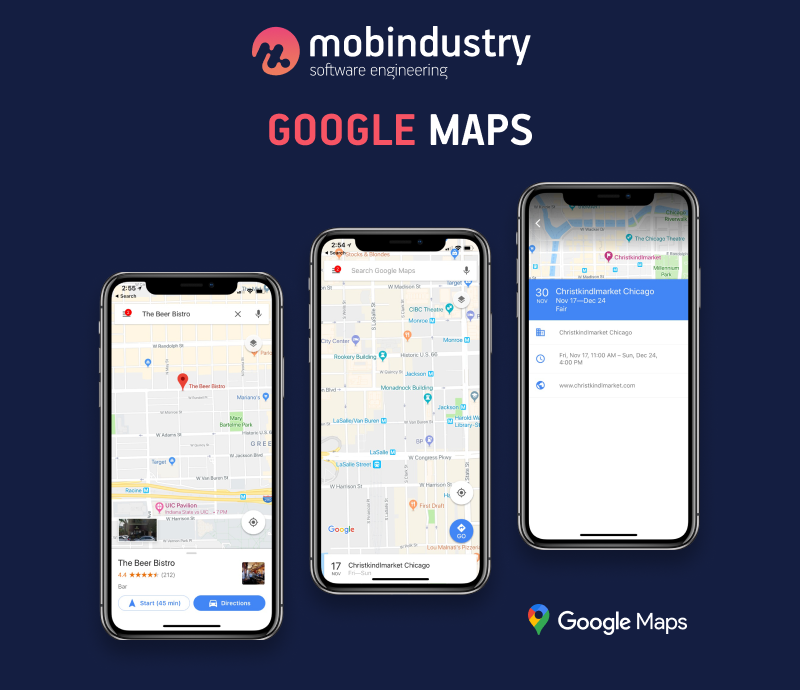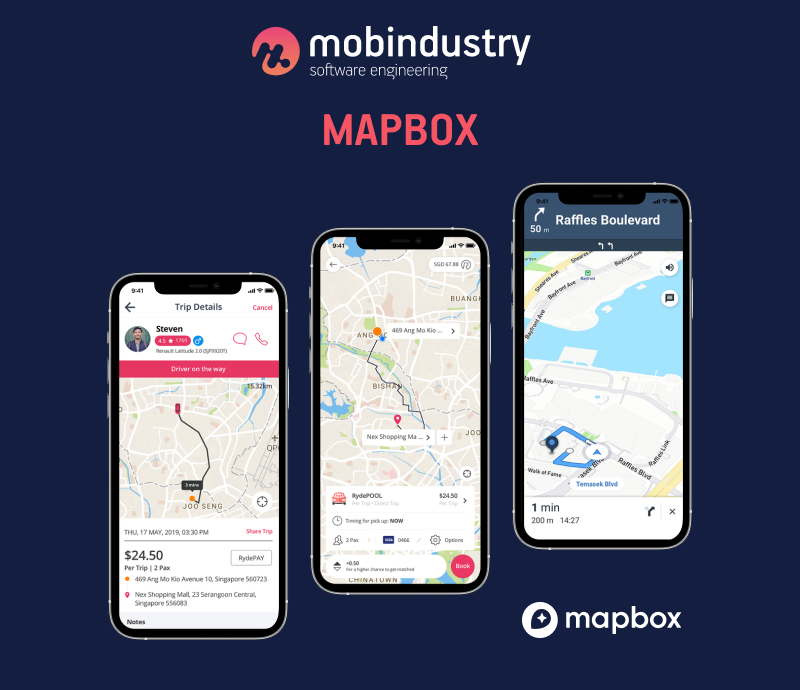Best Map API for Location-Based Services: Mapbox vs Google Maps vs OpenStreetMap
In this article, we compare the three most popular mapping services: Mapbox, Google Maps, and OpenStreetMap. Find out which is best for your project.
Mapping solutions is essential when it comes to logistics software. Choosing the right mapping tool can lower your operating costs and help you establish trusting cooperation with clients. Let’s find out which mapping solution will suit your business more.
Google Maps

While it seems like Google Maps has been around since time immemorial, it’s not Brontosaurus when it comes to updating data and providing new features. Especially when the pricing policy changes — but we will return to this later.
GMP, or the Google Maps Platform, has 99 percent global reach and over 1 billion monthly active users. It has long been the industry standard for map integration and is used by Bolt, Uber, Allianz, and many other large and small businesses.
Using satellites, Street View cars, and Android devices as well as by gathering data from local participants, GMP provides vast amounts of detailed and accurate data in real time. And the GMP products (Maps, Routes, and Locations) are designed to meet the needs of any industry — if businesses can handle the price.
Pros & cons of using Google Maps
Google Maps is based on reliable navigation data and has over one billion monthly active users. Here’re the pros and cons, that you can come across with when working with Google Maps.
Pros
Quality data
With Google satellites, Street View cars, and custom fixes, Google’s geographic coverage is top-notch.
Style variety
Google Maps use the JSON-like syntax that gets loaded instantly along with the map. It dive you the opportunity to can control the visibility, color, and transparency of all map components.
Street View
The Street View feature produces engaging panoramas from various angles of streets all over the world. So, how businesses can benefit from using this feature? For example, as a restaurant owner you can integrate Street View into your mobile app and allow clients to virtually visit the restaurant, check out its atmosphere, and find out see where on the street it’s located .
Language support
Google Maps is notorious for its multiple language support. Your product that includes Google Maps solution can be used all over the globe.
Instantly recognizable
Most smartphone and computer users are familiar with the Google Maps interface, which will likely inspire a sense of trust when interacting with the version built into your application.
Excellent global and local data quality
Google Maps has won global popularity with the help of their mapping services and has collected immeasurable amounts of local information.
Cons
Browser restrictions
Not all web browsers support the Google Maps JavaScript API.
Usage restrictions
Google Maps restricts the number of requests a user is allowed to send per second. You can find an information about restrictions on the Google Maps website.
Few customization options
Although new custom styles are being released in beta, the Google Maps API currently has limited support for creating a unique look and feel when maps are integrated into an application.
Not an open-source API
Whether it’s because Google requires no help from the developer community or because the corporation is holding on to the right to implement certain features without external consent, this is simply the way things are.
Problematic pricing
Google Maps’ pricing is a bit hard to understand. Here comes the gimmick: to gain users interest, Google allocates $200 per user for API calls every month. The moment that amount is spent, Google starts charging you. The price hike for the Google Maps API in 2018 made a splash among loyal users. A great service like this deserves to be monetized and should be profitable, but customer trust is another currency worth saving.
Mapbox

Mapbox provides map data and analysis to non-profit environmental and humanitarian organizations and has grown into an industry giant. While providing customizable maps and location tools to big players like Facebook, Snapchat, and Foursquare, the company is also meeting the needs of local entrepreneurs.
Although the services are no longer free, Mapbox remains true to its open source code, releases code, and contributes to numerous libraries and mapping applications. Mapbox offers a complete set of features and tools to integrate its map services into any website or mobile application.
With Mapbox Studio, customers can create unique designs to easily integrate maps into their products. If you need data visualization, turn-based navigation, logistics management and search function of shops, MapBox can help you by giving carte blanche to create a map that corresponds to your application.
Pros and cons of using Mapbox
Pros
Сustomization options
Based on reviews we can make a conclusion that Mapbox is more customizable than Google Maps. Lots of mapping systems out there offer ready-made maps, but Mapbox is a bit more special than others. It provides developers with a customizable set that they can assemble based on their preferences and needs. With Mapbox you can make a map style that matches your brand. Developers are able to install fonts and color palettes and add features such as step-by-step instructions and terrain information.
Open-source SDKs
Mapbox Maps provides its users with open-source SDKs. You can find Mapbox’s code on GitHub. Lots of professional developers contribute to the codebase daily. Mapbox GL Native served as a bases for Mapbox Maps SDKs. The library gives you the opportunity to implant custom interactive vector maps into your own applications on multiple platforms.
Integration with PubNub
Mapbox has partnered with PubNub, which offers infrastructure as a service for real-time streaming, creates dynamic map visualizations from real-time data, and includes features such as asset tracking, geocoding, and heatmaps.
Mapbox AR
The Mapbox Maps SDK for Unity allows you to create location-based services using points of interest (POIs) around the world. You can add locations using draggable maps and POIs, 3D buildings and terrain, location-based augmented reality, and more.
Offline maps
The Google Maps API doesn’t have an offline mode. More precisely, the offline mode is available in the company’s Google Maps application; however, it is limited to the application itself and is not available through the API, so it cannot be integrated into other products. Mapbox provides greater flexibility in its offline mode. Through the use of vector maps, Mapbox supports offline access. Apps built with the Mapbox Mobile SDK can download maps of selected geographic areas when the device is turned off. In addition, Mapbox mobile SDKs automatically cache tiles and other resources requested during normal use.
Fast loading
Mapbox provides excellent performance with large amounts of data. Thanks to the tileset architecture and Mapbox GL JS optimizations, you can expect faster integrated map loading and smoother rendering than with Google Maps, especially when dealing with complex datasets.
Standardized data handling
Dealing with the very strict internal data management rules in Mapbox takes some getting used to, but it pays off in the end — and your developers will appreciate them.
Cons
Inferior map coverage in certain regions
Mapbox relies on collective mapping, and OpenStreetMap (OSM) is its primary data source. This has implications. Although the OSM project has grown significantly over the past ten years, its coverage in regions such as India and China is still wanting.
Time-consuming learning curve
It will take some time for developers to learn the basics of the Mapbox API environment, in particular the data flow and data flows and data standardization. But this is only true for those who have no experience with Mapbox.
OpenStreetMap
OpenStreetMap is a community-supported map project that provides data to numerous websites and applications. This map is open-source and completely free to use while maintaining a high level of accuracy and detail thanks to the efforts of local map enthusiasts and engineers who complete and maintain it. In fact, it’s so good that Mapbox uses OSM as the basis for its maps.
OpenStreetMap: Pros and Cons
The OpenStreetMap project can be used as an excellent data source. Here are several advantages and disadvantages to consider.
Pros
The OpenStreetMap API is free
There are no additional costs for your business.
Open source map
A large number of contributors with a passion for mapping are driving the continued growth of the database.
Cons
Requires creating additional services
The API was designed for updating and editing maps and has very simple functionality. You will either have to build the necessary infrastructure on-site or use off-the-shelf, general-purpose solutions (such as Mapbox) based on OSM data.
Limited number of queries
Excessive data exchange via the API is discouraged, and users can get locked out without notice when executing too many data requests.
Mapbox, Google Maps, and OpenStreetMap pricing
Let’s talk about the price you have to pay for all the bells and whistles. The OpenStreetMap API is free, so we’ll only talk about the two paid products. While Google Maps and Mapbox use complex and often similar pricing models, there’s one important difference in their approach to billing: Google exclusively measures the number of queries, whereas Mapbox can account for the number of users.
Depending on your use case and the methods used to integrate maps into your application, Mapbox offers you a variety of pricing options to choose from, while Google Maps has a single server load–based pricing approach. Both companies offer monthly discounts: Google gives a $200 monthly credit and Mapbox gives user experience or API requests, with up to 750,000 free API calls in some categories.
You’ll only be able to estimate the total cost of using these services if you have a clear idea of the use cases for your built-in map as well as the approximate number of monthly users. But even at this stage, it looks like Mapbox will have a cost advantage (especially for data-heavy projects), and your savings will only increase as your user base grows.
What do these three APIs have in common?
Since the OpenStreetMap API has very limited standalone functionality for integrating with other applications, let’s look at the similarities between Google Maps and Mapbox.
Google Maps and Mapbox meet the same needs, and as such they have similar features. Let’s take a look at some of the features both APIs share:
- Core map functionality: Static and dynamic maps; precise and detailed geographic and local data in various selectable views; the ability to add markers, polygons, and images
- Navigation: Real-time routes based on congestion, route optimization, and estimated arrival times
- Local information: Detailed information about places and sights
- Advanced search options: Automatic prediction and correction, location-based suggestions
Key differences between Google Maps, Mapbox, and OpenStreetMap
- Customization. It looks like Mapbox is in the lead here, with Google Maps getting a few less points and OSM clearly losing.
- Operating cost. OpenStreetMap wins this handily. As for Google Maps and Mapbox, you need to be very careful when comparing costs for the same use case, but we’d still give Mapbox an edge in most cases.
- Feature value. If you’re comparing Mapbox to Google Maps, you should look for specific features that your integrated map service requires, as both services are well equipped for most tasks.
- Ease of integration. Again, this will largely depend on the experience of your designers and developers with the respective APIs and SDKs. Some will prefer Google Maps because of its popularity, while others will be comfortable with all three APIs.
Final thoughts on how to choose a map API
Comparing these three tools based on the above criteria will help organize your thoughts. But if your goal is to choose the right solution for your business, we recommend answering the following questions:
What map functionality do I need for my business?
Are you a service company with employees who frequently travel to many locations for service and repairs? Use advanced Google navigation algorithms, but don’t forget about the absence of offline mode in the GMP API.
If you need basic map integration like a built-in static map to provide your customers with simple location services, feel free to use OpenStreetMap, but keep in mind that you’ll need to build a basic infrastructure around its API.
If you need to aggregate and visualize large amounts of data to turn it into actionable information, Mapbox has some experience in this area.
How large is my user base now, and what growth do I expect?
Zoom in, set a goal, or start daydreaming. Whatever numbers you come up with will be useful in predicting your usage and what discounts you can expect from your chosen service (should you exceed the free tier limits). The size of your user base will also affect the quantity and quality of data your application can process, which will be critical when choosing an API with data management best practices.
Where does my business operate geographically?
You can browse the online documentation for each API to see which platform is best for your region. Mapbox, for example, is fairly honest about the quality of its traffic data by country.
Does the open-source model appeal to me?
This may be an important point of disagreement for some or not a problem for others. It’s something to consider from both an ethical and a practical standpoint.
If you want to add a mapping solution to your app but don’t know where to start, contact Mobindustry for a free consultation.


